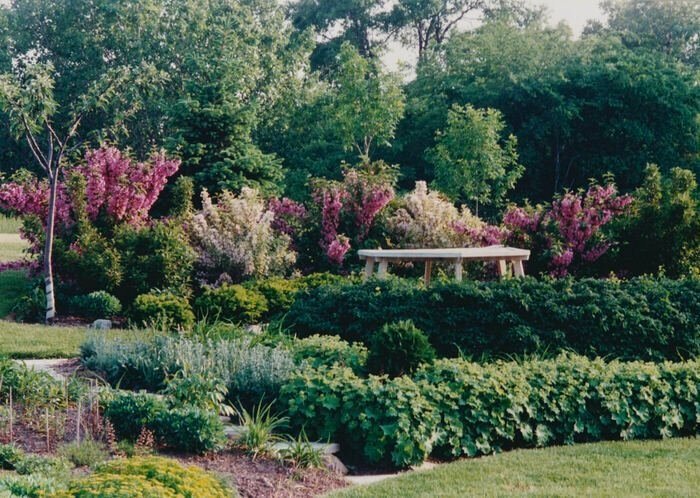
Bling Prairie
Most of the gardening efforts during our first ten years went into the backyard. In 1993, Ken made the plans at left to expand the garden around the upper patio in the SE corner. Below, the weigelias are in full bloom, the apple tree is nearly as tall as the corner evergreen, and a path of pavers and steps have been added.
In the Bling Prairie in 1995, Ken planted a row of seven crab apple trees for which he dug a trench 2 ft deep and 4 ft wide. Our neighbor Paul Harris stopped over at the time and said, “If Jean goes missing this winter, we’ll know where to look.”
A garden is never finished. After seeing Ken lift out entire plantings and place them on the canvas tarp before replanting them in other locations, I used to suggest he grow them in pots with wheels so that he could just scoot them around. The early gardens were heavily influenced by Oehme and van Sweden’s The New American Garden. There were many varieties of daylilies in those early gardens, but the daily deadheading by the meticulous gardener led to reductions to only the most favorite. By 2014, trellises with tomatoes edged much of the property line. The hexagonal wood table of the early years was replaced with a new outdoor table and chairs, and the area became an inviting and private outdoor space for meals and breaks.
In 2019, the Bling Prairie section was booked for renewal. Tom and Jen arrived to help with the heavy lifting. All of the sedum and Miscanthus of the Oehme and van Sweden years gave way to a big bluestem “Blackhawks” and other prairie plants. In renewal efforts, pacing is everything as demonstrated by Tom on the chaise lounge.
Since dahlias were becoming key players in several of the updated gardens, winter storage of the tubers became important. During his early efforts at overwintering, Ken lost 100% of them the first year and about 70% in the next two efforts. In 2019, he built an insulated dahlia storage box in the garage. It has a thermometer with a controller that triggers a heater and a fan to keep the space between 38 to 45 degrees F all winter. After digging, cleaning, labeling, and packing them in November with the help of our friend Sandy Burrus, the tubers head into the storage box for an expected 95% survival rate.
In mid-January, part of the basement becomes garden headquarters for seed starting and cuttings propagation. Five folding tables are assembled and 15 grow-lights are hung and the season is underway!

